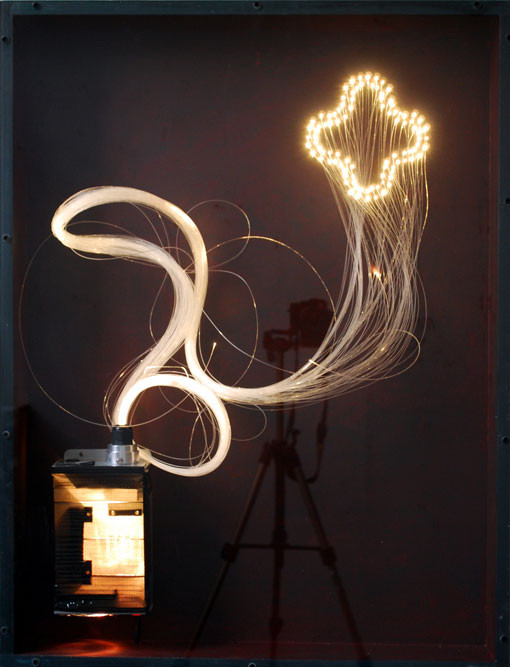Daniel Pasteiner
15 Nov 2008 - 17 Jan 2009

Daniel Pasteiner, Polaris, 2008, Fiber optic mechanism, oil, Perspex, wood, 85 x 65 x 11 cm / 33 1/2 x 25 5/8 x 4 3/8 inch
Within the framework of the Suzie Q Projects, Birgid Uccia and Bob van Orsouw look forward to the first-time presentation in Switzerland of Daniel Pasteiner in a solo exhibition of his paintings and sculptures. Pasteiner was born 1980 in Kuwait City and today lives and works in London.
For his art-historical reference points, Pasteiner relies on the positions of abstract painting on the one hand, especially those that draw on ornaments from different cultures, and on the other hand refers to the spontaneous gesture of Dadaism that raises an everyday objet trouvé to an art work. His works are a symbiosis of abstract formalism with thematically charged ready-mades.
Painted records and toy Tyco tracks are the structure within the ornamental abstract painting “Fortress”. The objects deployed here seem to combine on their own into a Gothic quatrefoil – a figure that repeatedly turns up in Pasteiner’s painting as well as in his sculpture.
The quatrefoil as an element in Gothic architecture and book illumination is considered a symbol of the terrestrial, but also an emblem of the divine. In the same way, the two general artistic tendencies to which Pasteiner is aligned can be seen as an allusion to the worldly (objet trouvé) and the sublime (abstract painting). Profane, often nostalgic, everyday items such as toys, vinyl records and an exercise machine from the 1980s are arranged by the artist into new assemblages and formulated in colour, sparking their transcendence into mystical art objects.
The technicized sculptures, however, seem more to conjure up an association with a mysterious science-fiction universe than with a world of medieval mysticism. This impression is underlined by the use of illuminated neon tubes, light bulbs and similar light effects, as in the sculpture “Polaris” – a title that surely not by chance resembles Stanisław Lem’s famous science fiction novel “Solaris”, in which the author raises epistemological, anthropological and cosmological questions typical for the genre. In this context, the “Decorative Piece for Wall”, illuminated from behind, appears to be the depiction of a solar eclipse or, in fact, that bleak planet from Lem’s novel.
Pasteiner’s works are innately infused with a mysterious ambiguity. Thus the question remains open, whether the photograph “Afternoon” – in which, against a Swiss mountain panorama, a cluster of vapour trails ascends auspiciously into the blue, blue sky – is merely a snapshot of an air squadron exercise or indeed pictorial proof of a planetary exodus of Biblical magnitude that documents humanity’s embarkation to new interstellar shores.
Christiane Büntgen
For his art-historical reference points, Pasteiner relies on the positions of abstract painting on the one hand, especially those that draw on ornaments from different cultures, and on the other hand refers to the spontaneous gesture of Dadaism that raises an everyday objet trouvé to an art work. His works are a symbiosis of abstract formalism with thematically charged ready-mades.
Painted records and toy Tyco tracks are the structure within the ornamental abstract painting “Fortress”. The objects deployed here seem to combine on their own into a Gothic quatrefoil – a figure that repeatedly turns up in Pasteiner’s painting as well as in his sculpture.
The quatrefoil as an element in Gothic architecture and book illumination is considered a symbol of the terrestrial, but also an emblem of the divine. In the same way, the two general artistic tendencies to which Pasteiner is aligned can be seen as an allusion to the worldly (objet trouvé) and the sublime (abstract painting). Profane, often nostalgic, everyday items such as toys, vinyl records and an exercise machine from the 1980s are arranged by the artist into new assemblages and formulated in colour, sparking their transcendence into mystical art objects.
The technicized sculptures, however, seem more to conjure up an association with a mysterious science-fiction universe than with a world of medieval mysticism. This impression is underlined by the use of illuminated neon tubes, light bulbs and similar light effects, as in the sculpture “Polaris” – a title that surely not by chance resembles Stanisław Lem’s famous science fiction novel “Solaris”, in which the author raises epistemological, anthropological and cosmological questions typical for the genre. In this context, the “Decorative Piece for Wall”, illuminated from behind, appears to be the depiction of a solar eclipse or, in fact, that bleak planet from Lem’s novel.
Pasteiner’s works are innately infused with a mysterious ambiguity. Thus the question remains open, whether the photograph “Afternoon” – in which, against a Swiss mountain panorama, a cluster of vapour trails ascends auspiciously into the blue, blue sky – is merely a snapshot of an air squadron exercise or indeed pictorial proof of a planetary exodus of Biblical magnitude that documents humanity’s embarkation to new interstellar shores.
Christiane Büntgen
